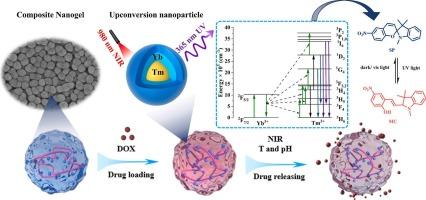微乳液聚合法制备上转化纳米颗粒包埋的三响应纳米凝胶,用于近红外控制给药
IF 6.3
2区 化学
Q1 POLYMER SCIENCE
引用次数: 0
摘要
人们普遍认为,紫外光容易对组织有较浅的穿透性和潜在的细胞光毒性,限制了其在生物医学领域的进一步应用。为了克服这一缺点,通过光响应型SPMA、温度敏感型n -异丙基丙烯酰胺(NIPAM)和ph响应型甲基丙烯酸(MAA)的乳液聚合,构建了一种新型的三响应型纳米凝胶(β-NaYF4:Yb,Tm),嵌入上转化纳米颗粒(UCNPs)。通过一系列的表征,证明了复合纳米凝胶的成功合成。通过ucnps介导的光激活,该体系在pH、温度和近红外(NIR)光的作用下表现出可逆的体积变化。以多柔比星(DOX)为模型分子,复合纳米凝胶的载药效率可达到53.06±1.58%。在紫外光、近红外光和pH = 3 & 30°C条件下,纳米凝胶的释放效率分别为90.53%、73.64%和82.17%,而在正常生理条件下(pH = 7,36°C),纳米凝胶的释放效率最低(<6%),证实了纳米凝胶的可控释放行为。药物释放过程可以很好地符合Weibull模型。细胞相容性实验证实了纳米凝胶的安全性(500 μg/mL活性为87.6%),而负载dox的纳米凝胶对A549细胞具有显著的细胞毒性(活性≤10%,p≤0.001)。这项研究强调了ucnps掺杂纳米凝胶在智能、按需和微创癌症治疗方面的潜力。本文章由计算机程序翻译,如有差异,请以英文原文为准。

Construction of triple-responsive nanogel embedded with upconversion nanoparticles via microemulsion polymerization for near-infrared-controlled drug delivery
It was generally accepted that ultra-violet (UV) light was prone to suffer from shallow tissue penetration and potential cell phototoxicity, limiting its further application in biomedical field. To overcome this shortcoming, a novel triple-responsive nanogel embedded with upconversion nanoparticles (UCNPs), β-NaYF4:Yb,Tm, was constructed by emulsion polymerization of photo-responsive SPMA, temperature-sensitive N-isopropylacrylamide (NIPAM), and pH-responsive methacrylic acid (MAA). A series of characterizations were used to prove successful synthesis of the composite nanogel. The system exhibited reversible volume change in response to pH, temperature, and near-infrared (NIR) light, enabled by UCNPs-mediated photoactivation. With doxorubicin (DOX) as a model molecule, drug loading efficiency of composite nanogel could attain relatively high value of 53.06 ± 1.58 %. High release efficiency of 90.53 % could be achieved under UV light, 73.64 % under NIR light, and 82.17 % at pH = 3 & 30 °C, with minimal release efficiency (<6%) under normal physiological condition (pH = 7, 36 °C), confirming controllable releasing behaviors of the nanogel. Also, the drug releasing process could be well fitted with Weibull model. Cytocompatibility assays confirmed the nanogels’ safety (87.6 % viability at 500 μg/mL), while DOX-loaded nanogels showed significant cytotoxicity toward A549 cells (≤10 % viability, p ≤ 0.001). This study highlighted the potential of UCNPs-doped nanogels for smart, on-demand, and minimally invasive cancer therapy.
求助全文
通过发布文献求助,成功后即可免费获取论文全文。
去求助
来源期刊

European Polymer Journal
化学-高分子科学
CiteScore
9.90
自引率
10.00%
发文量
691
审稿时长
23 days
期刊介绍:
European Polymer Journal is dedicated to publishing work on fundamental and applied polymer chemistry and macromolecular materials. The journal covers all aspects of polymer synthesis, including polymerization mechanisms and chemical functional transformations, with a focus on novel polymers and the relationships between molecular structure and polymer properties. In addition, we welcome submissions on bio-based or renewable polymers, stimuli-responsive systems and polymer bio-hybrids. European Polymer Journal also publishes research on the biomedical application of polymers, including drug delivery and regenerative medicine. The main scope is covered but not limited to the following core research areas:
Polymer synthesis and functionalization
• Novel synthetic routes for polymerization, functional modification, controlled/living polymerization and precision polymers.
Stimuli-responsive polymers
• Including shape memory and self-healing polymers.
Supramolecular polymers and self-assembly
• Molecular recognition and higher order polymer structures.
Renewable and sustainable polymers
• Bio-based, biodegradable and anti-microbial polymers and polymeric bio-nanocomposites.
Polymers at interfaces and surfaces
• Chemistry and engineering of surfaces with biological relevance, including patterning, antifouling polymers and polymers for membrane applications.
Biomedical applications and nanomedicine
• Polymers for regenerative medicine, drug delivery molecular release and gene therapy
The scope of European Polymer Journal no longer includes Polymer Physics.
 求助内容:
求助内容: 应助结果提醒方式:
应助结果提醒方式:


